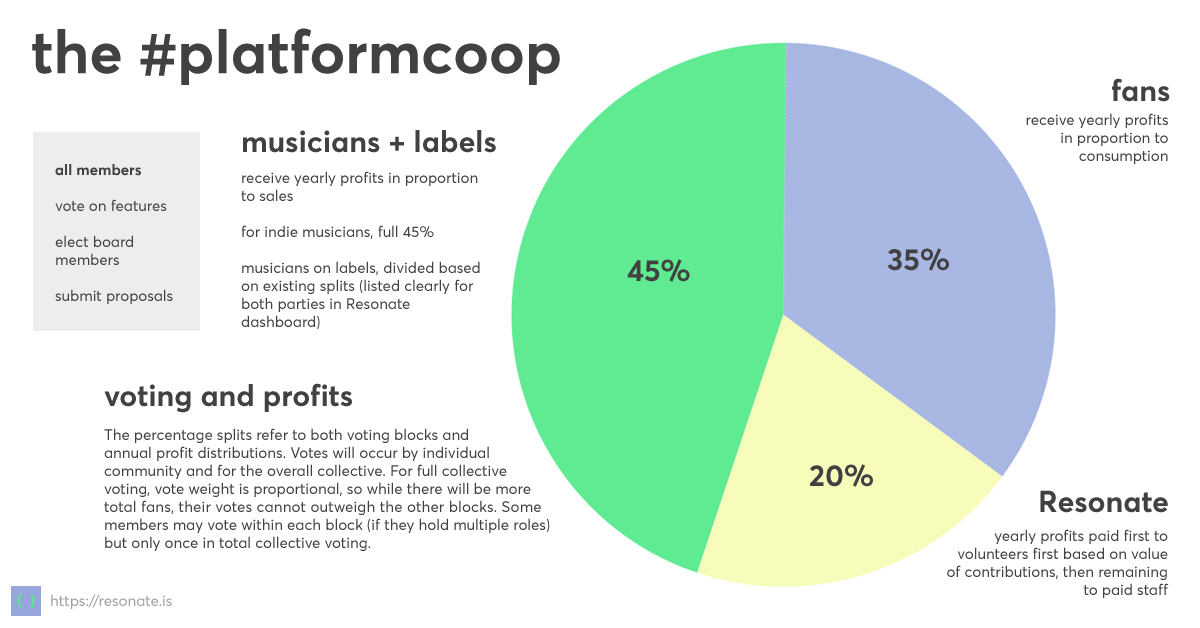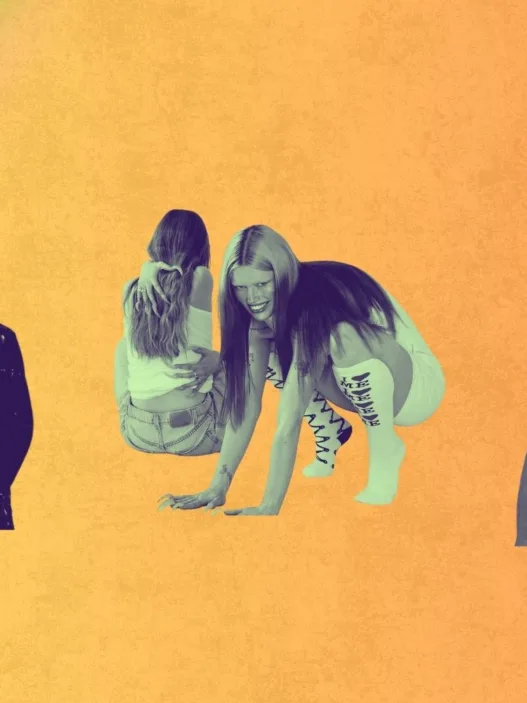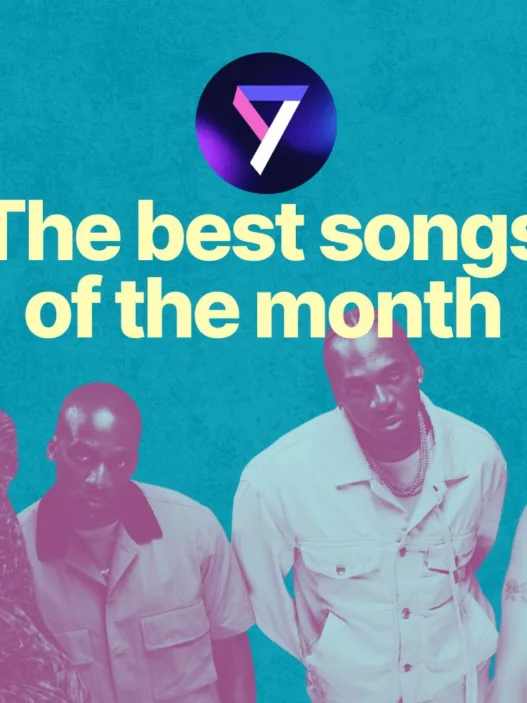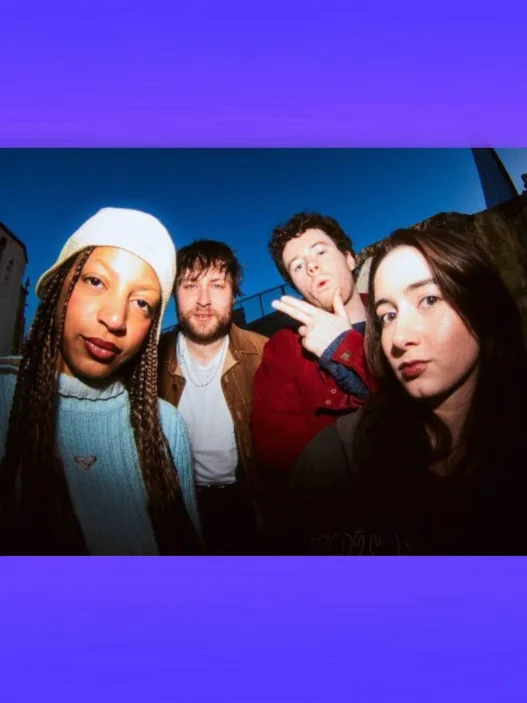Belfast-based songwriter Joel Harkin wrote to us in response to our alternatives to Spotify podcast, and went into depth about the services on offer. So I asked him to expand on his reply as others may find his findings useful.
After the latest controversy at Spotify, I think it is a good idea to take stock of where we’re at with all of this streaming malarkey and what we can do as music listeners to support artists in the ways that help them the most.
There are some great alternatives to Spotify out in the world now but they are not without their individual failings so let’s have a wee chat about them.
Resonate.is

They say: Resonate is a streaming music service cooperative owned by the people that use it – musicians, indie labels, fans + developers. Stream it until you own it.
Resonate are a music streaming co-op owned by their members (we love to see it) that offer a direct to fan, ‘stream to own’ model.
How it works as a listener is you would buy credit for your Resonate account and then every time you listen to a specific track some of your credit would go from your account to the artist that is responsible for the track you are listening to.
To avoid spending all of your credit listening to songs for the first time, not knowing whether or not you even like that track yet, the frequency of plays on a specific track from a specific account weighs the payment differently.
So the first time you listen to a song on Resonate, you pay about €0.0024 for that stream, and after your ninth stream of a particular track you will have paid about €1.25 altogether for it, and then you own it.
As Resonate is a stream to own platform, after the ninth time you listen to a song, no more credits will come from your account to allow you to listen to it as you now own it. This is the first major issue I see with Resonate. They say themselves on their website that:
‘After you’ve purchased or played a track nine times, you’ve paid in full. Resonate then houses the track as a music library full of your music, now free to stream. As a result, the cost of using Resonate decreases over time, as music is added to your collection.’
The cost of Resonate decreases over time, which in essence means over time, less money will be going from you to the artists you love, unless they release more music. There is no real benefit to an artist to have repeat listens on Resonate after their album has been streamed nine times by a specific listener. That work is still being communicated and yet after that point, no longer will generate any royalties for the artist. I don’t believe putting less money into the tool you use to listen to music over time is necessarily the best thing for music makers.
Another quote from their website:
‘What takes other services 200 plays, we do in 9 with stream2own.’
Again I can see the appeal here. It takes far less streams for the artists to make more money than they otherwise would in a standard revenue share model streaming service like Apple Music or Spotify. But something to consider is that there is no cap in revenue on these services. It may only take nine streams to pay the same as 200 streams do on RS services, but 400 streams on a RS service won’t equate to 18 Streams on Resonate because after those initial nine streams, you own the track, and the artist no longer generates a royalty from you listening.
What this means is that nine streams on Resonate will generate much more revenue for an artist than nine streams on Spotify, but 1000 streams on Resonate will generate significantly less revenue for an artist than 1000 streams on a revenue share service, when talking about streams from a single track.
Some other things that I think will hinder Resonate are:
i) The system of credit instead of a monthly subscription. I much prefer having a pay as you go monthly phone plan than buying credit and it running out at inopportune times.
ii) The lack of royalty splitting. As far as I can tell from what is on their website, like Bandcamp, Resonate are a direct to fan service and may not handle publishing royalties on their end.
Bandcamp

That second point leads me to my gripe with Bandcamp.
I’d like to say that I love Bandcamp and am an avid user but nothing is perfect and most things can be improved and this is just how I think Bandcamp can be.
By not handling publishing royalties, services can leave a mess of paperwork for artists and labels who may have multiple different writers on multiple different tracks. Keeping up with who needs paid what and how much at the end of every month is a headache for artists and labels to have to deal with. It is something that I think services should offer.
Whether that takes the guise of services paying the publishing cut of the royalties to a PRO and letting them distribute it to songwriters and publishers, or simply having the ability to set up royalty splits on their services by artists so that when music is being distributed and payment eventually comes in in the shape of royalties on Resonate or a one-off purchase on Bandcamp, the songwriters are automatically paid a cut directly based on what was agreed with the artist and what was set up in the royalty split. It makes a lot of sense.
The point about perpetual revenue streams also applies to Bandcamp. You do make a lot off of that initial purchase but listening through the Bandcamp app offers no extra royalties. After you have bought an album you can listen to it once or a million times, an artist will only get the amount charged for it and that’s that. And there’s nothing wrong with it, in most cases it’s better for the artist, a larger sum of money than most will make from streaming in a much shorter amount of time but we can do better. Most things can be improved on.
(Just want to say again I love you Bandcamp, thank you for waiving your fee to help artists so often you are great but please add an option to auto split royalties when sales occur so that it’s not a headache keeping up with releasing co-writes on your platform. Thank you so much. Love you!)
User Centric Payment Systems

They are class. I’m all about a user centric payment system sham. UCPS ensures that the money from a listener’s subscription will only be distributed to artists that they have actually listened to in that subscription period. So If your subscription is €10 and you listen to nothing but Dani Larkin tunes for the entire month, Dani Larkin is going to get €7 of your subscription as most streaming services take 30% of the subscription for their own cut. It’s how they make money.
In the revenue share model used by Spotify (aka the pool system), in the same instance as before you listen to no one but Dani Larkin in the entire month, let’s say you listen a thousand times across the whole month. Usually a thousand plays equates to about €4 in royalties from most revenue share streaming services. Can you see the discrepancy here? Your subscription costs €10, the service will likely take €3 as a fee, the artist you’ve spent all month listening to, a thousand times in fact will receive €4, where does that extra €3 from your subscription go? Into the royalty pool and distributed to artists that you haven’t listened to.
Thinking about this on a larger scale, it is estimated that 5% of streams are fraudulent, coming from bots and used to inflate the streams of particular artists for the appearance of having more streams and/or the royalties that these streams would generate. User Centric would cut out the monetary side of that equation as it wouldn’t make economical sense to charge for bot listens as the most that can be made from a single account would be the price of the subscription minus the services cut.
In a user centric system, if the subscription is €10, and during the whole month I only listen to one song and one song only, ‘Leave Me at Lusk’ by Cloakroom Q. Let’s say I leave it on repeat for the whole month, streaming it about 8640 times give or take, in a user centric model Cloakroom Q would still only receive a royalty equating to the price of my subscription minus the service fee which in this instance would generate them €7. Each stream drives down the price of my accounts per stream payment and no one else’s as it does in a revenue share model.
There’s a great video and article on Deezer’s website that explains it very well with nice animations and graphics. https://www.deezer.com/en/ucps
Lets talk about the streaming services that tout the greatness of UCPS and those that currently offer UCPS as their system of choice.
Deezer

Deezer have been shouting about UCPS since 2017 and I applaud them for it. So one would assume if they are touting how class UCPS are then they must be using that method of royalty distribution right? Wrong, unfortunately. It’s not as easy as just deciding to switch over. Streaming services have deals and contracts with labels and distributors that include terms on how royalties are distributed. If a streaming service wants to change their method of royalty distribution, all of these deals and contracts would have to be re-evaluated and changed and agreed upon. It is something that would cost a lot of money and would take a lot of time.
When making this point to the many people I talk endlessly about UCPS to, some have rebutted:
‘oh what you’re saying canny be true because Soundcloud were able to switch over just like that so why can’t the rest?’
Soundcloud

And I suppose there is a bit of truth to that. Soundcloud did change their royalty distribution method seemingly at the drop of a hat but there is a bit more to it than that. User Centric Royalties are only from Premium Soundcloud accounts and only for artists that distribute with Soundcloud’s distribution service called Repost.
So unless you’re doing your listening on a Soundcloud Go+ account and the artist you are listening to distributes their music with Repost by Soundcloud, there is likely no user centric payment of royalties happening. Soundcloud have said that they have just started with this and plan to expand but so far there’s no sign of this happening.
TIDAL

TIDAL are also offering a user centric model similar to Soundcloud, in a limited capacity. Users who subscribe to their higher payment tier, the €20 a month tier, will have their royalties distributed under a UCPS, but accounts on the standard €10 a month tier will have their royalties distributed under a revenue share model. Why would TIDAL do this?
Introduce a user centric system (fan powered royalties is what they are calling it) in the tier that will have fewer users? This is just speculation but my theory is that the €20 a month tier is a smaller sample set with which to test the effects that a UCPS will have on the labels and distributors. TIDAL would have had to negotiate with lots of labels and distributors in order to be able to offer their fan powered royalties and maybe this was one of the compromises, so that labels and distributors would be able to see what they are getting themselves into before they commit to changing all of the contracts and deals. Just a theory but I think it has merit.
TIDAL are also offering something that they are calling “direct artist payouts” in conjunction with their fan powered royalties. Direct artist payments are payments that go directly to the artist that you have streamed the most in the last month, and that payment doesn’t come from your cut of the subscription, it comes from the 30% cut that TIDAL take. The payment will not appear with the other royalties but will be sent directly to the artist via a payment processor like Paypal or Cashapp.
I think this is important in understanding TIDAL’s motivation for changing to a user centric model. They have said when they announced the change that they wanted to pay artists more fairly and that this was a good way to do it. I agree with them, I think User Centric is a fairer way for artists to be paid. However it is also worth noting that the payment processing company Square, are now majority owners of TIDAL and it was after they became majority owners that they introduced the direct artists payments, Square, being a payment processor, no doubt will be an option for payouts and who will also no doubt take a small fee each time for doing so.
Square becoming a majority owner in TIDAL and then trying to switch TIDAL over to a payment system that pays artists more fairly is also strange to me seeing as Square CEO, Jack Dorsey, who was the CEO of Twitter for six years, used the same safe harbour laws on Twitter that Youtube use to avoid paying artists properly.
Spending 6 years as a CEO of one platform who avoided paying artists royalties and then becoming the CEO of another which is now a majority owner in a platform that’s main selling point is that it has mostly the same catalogue as Spotify and pays artists fairly is sus to me sham. Anyway whether it was a change of heart or it was just a way to get more people on the platform, at the end of the day, they are the only service with a full catalogue who are offering user centric so I’m still on board until something better comes along anyway.
MINM

And something better is coming along and it is called Minm. Minm is a new streaming service based in Ireland. The brain child of Luke Lau and Daniel Cosgrove, Minm is a streaming service that is fairer for artists and more transparent. While other services take a 30% cut, Minm take only a 10% cut, leaving 90% to be distributed to artists using a User Centric Model. My issues with Resonate and Bandcamp, deal with publishing, royalty splitting and perpetual streams of income.
Minm has paid a license to IMRO so songwriters will be paid, they are also currently in talks with PRS. Royalty splits will be implemented, and in terms of perpetual income because it operates as a streaming service, you pay your subscription every month, you listen to your favourite artists every month and your favourite artists get paid every month. It’s very simple. They are very new and the service is still being put together but already there is a real community of artists and listeners who have released their music and have subscribed themselves to it. They are currently working on apps for iOS and Android but have plans for a lot more too. I would highly recommend having a wee look at their site.
How User Centric Models might impact new music promotion?
Some more speculation here for you, just something that I think will happen as a result of UCPS being adopted widely by all streaming services (if that ever happens. I hope it does). I don’t think artists would be as fussed about getting on editorial playlists anymore.
I think there are two different types of listener when it comes to streaming service. Active listeners and passive listeners. Active listeners are more invested in what they listen to, will choose specific artists and albums and would call themselves fans of those artists, passive listeners will maybe be fans of specific playlists because of the vibe. Active listeners are mostly listening with purpose and passive listeners are mainly listening in the background.
An active listener might listen to one or two albums a day whereas a passive listener will listen to loads of different artists on playlists. In a revenue share model the best way to make revenue from your tracks is to get on a playlist so the streams will go up. Because all streams are weighted equally each month, more streams means more revenue. In a user centric system, streams from different accounts will be weighted differently as the more artists you listen to, the smaller the amount of money each of those artists is going to get from your subscription. So it stands to reason that people listening to hundreds of different artists on playlists, their per stream play will probably be lower than people who are listening to a few full albums from a few different artists per day.
This would make building an actual active fanbase more favourable to artists than getting on an editorial playlist. And because editorial playlists wouldn’t be as sought after by artists anymore this may cause spotify and other services like it to lose their ability to influence, to be a tastemaker. Which is something I suspect that they do not want to lose.
Anyway, if you made it to the end, fair play to you. It was a long slog but you did it. You had a conversation about streaming and now to reward yourself here’s a conversation about punk.
You can listen to Joel Harkin’s music on Minm, Bandcamp and Tidal.

Niall Byrne is the founder of the most-influential Irish music site Nialler9, where he has been writing about music since 2005 . He is the co-host of the Nialler9 Podcast and has written for the Irish Times, Irish Independent, Cara Magazine, Sunday Times, Totally Dublin, Red Bull and more. Niall is a DJ, founder of Lumo Club, club promoter, event curator and producer of gigs, listening parties & events in Dublin.












